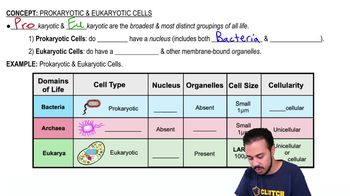Which of the following is present in a prokaryotic cell? a. mitochondrion b. ribosome c. nuclear envelope d. chloroplast
 Verified step by step guidance
Verified step by step guidance
Verified Solution
Key Concepts
Prokaryotic Cells

Ribosomes

Cellular Organelles

Which structure is common to plant and animal cells? a. chloroplast b. central vacuole c. mitochondrion d. centriole
Cyanide binds to at least one molecule involved in producing ATP. If a cell is exposed to cyanide, most of the cyanide will be found within the a. mitochondria. b. ribosomes. c. peroxisomes. d. lysosomes.
Which cell would be best for studying lysosomes? a. muscle cell b. nerve cell c. bacterial cell d. phagocytic white blood cell
DRAW IT From memory, draw two eukaryotic cells. Label the structures listed here and show any physical connections between the internal structures of each cell: nucleus, rough ER, smooth ER, mitochondrion, centrosome, chloroplast, vacuole, lysosome, microtubule, cell wall, ECM, microfilament, Golgi apparatus, intermediate filament, plasma membrane, peroxisome, ribosome, nucleolus, nuclear pore, vesicle, flagellum, microvilli, plasmodesma.
